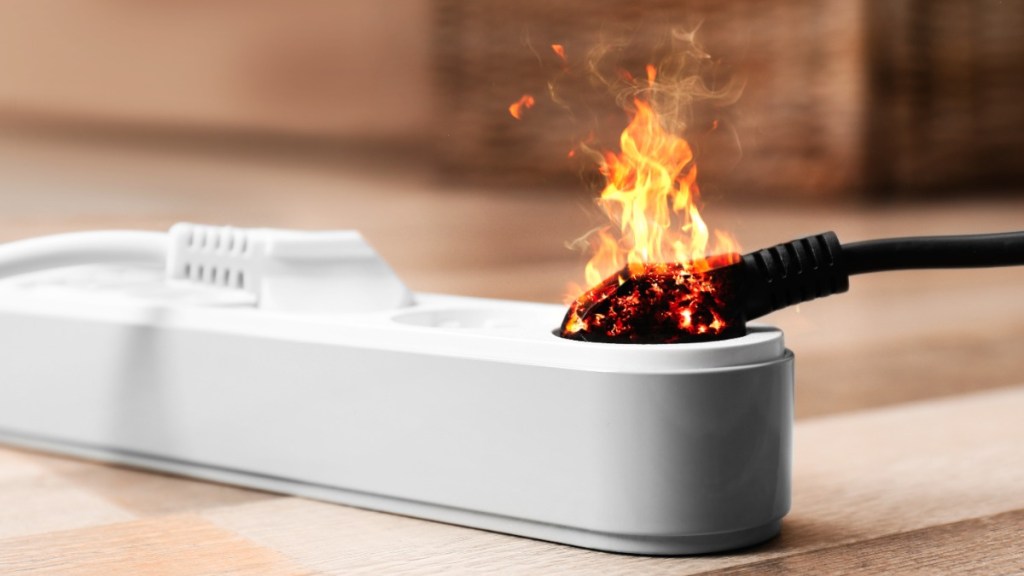If you have the opportunity to build a house, you can decide for yourself where and in which rooms sockets should be installed. The planning takes into account any candle arches, the Christmas tree, various lamps and, of course, the entertainment electronics. Tenants, however, do not have this luxury and so in many rooms there are multiple sockets that are filled to capacity. However, if you disregard a few rules, they can become a fire hazard!
Multiple sockets: 7 tips to avoid the risk of fire
According to experts, the danger of multiple sockets and power strips is all too often underestimated. Many people rely on the fact that the fuse will blow if the circuit is overloaded. Although this is true, an overload of the distribution socket can occur much earlier: Within a few minutes, it is then heated up to 200 °C – a smoldering fire occurs, which can develop into an open fire.
Damage and improper use of a multiple socket outlet can also lead to a fire. Therefore, always observe the following rules:
Keep the socket clean
Dust in multiple sockets can easily ignite. The Federal Institute for Occupational Safety and Health (BAuA) points this out. You should therefore clean multiple sockets regularly. Hiding multiple sockets under the cupboard or sofa is also not a good idea, as this is where dust tends to collect.
Pay attention to overall performance
A multiple socket outlet is only designed for a certain maximum power. As a rule, this is 3,500 watts. This means that the combined power of all connected appliances must not exceed 3,500 watts. An electric kettle often has up to 2,400 watts. If you then add a toaster with 1,200 watts, the multiple socket is already overloaded.
Typical appliances whose power is often underestimated are
- Hair dryer (approx. 2,000 watts)
- Microwave (approx. 800 watts)
- older vacuum cleaner (approx. 2,000 watts)
Large appliances such as washing machines, tumble dryers or dishwashers should always be connected to separate wall sockets.
Do not plug multiple sockets one behind the other
Turning a 3-way plug into a 6-way plug? Even if the idea seems tempting, multiple sockets should not be plugged in one after the other. This is because the power consumption is not distributed, but bundled. This quickly leads to an overload.
By the way: For this reason, the note “Do not plug in one behind the other” must also be noted on every multiple socket.
Do not cover
The multiple socket outlet becomes hot when it is heavily used. If it is not sufficiently ventilated, the heat can build up and lead to a fire – even if the load limit of the multiple socket outlet has not yet been exceeded. Therefore, make sure that multiple sockets are not covered by a carpet, curtain or other objects.
Banish from bathrooms and cellars
Normal multiple sockets have no place in basements and bathrooms. There is too great a risk of them being exposed to moisture. This can lead to corrosion or short circuits. Therefore, only use multiple sockets with protection class IP 44 and higher in these locations.
Attention: On the balcony and in the garden, you should only use special multiple sockets for outdoor use.
Replacing old multiple sockets
Multiple sockets do not have an expiration date. However, they cannot be used forever. Over time, the materials corrode and the cables become brittle. Old multiple sockets therefore become a permanent hazard. Check older multiple socket outlets regularly for discoloration or other visible defects and replace them as soon as possible.
You may also be interested in these articles:
Avoid cheap goods

The quality of multiple sockets can vary considerably. Cheap products often do not meet the necessary standards, which means they are overloaded more quickly or catch fire.
Look for the following signals when buying:
- Indication of maximum power: It shows how high the total wattage of the connected devices may be.
- Information on the manufacturer: Does the manufacturer take responsibility for the product?
- CE mark: Although the CE mark is not a seal of quality, it proves that the product complies with European directives.
- TÜV seal or GS mark: Multiple sockets with these seals have been tested by a recognized institute.
A fire in the home causes not only material but also non-material damage: things that are dear to us fall hopelessly victim to the flames. Safety is also an important issue with multiple sockets.
Source: swrfernsehen
